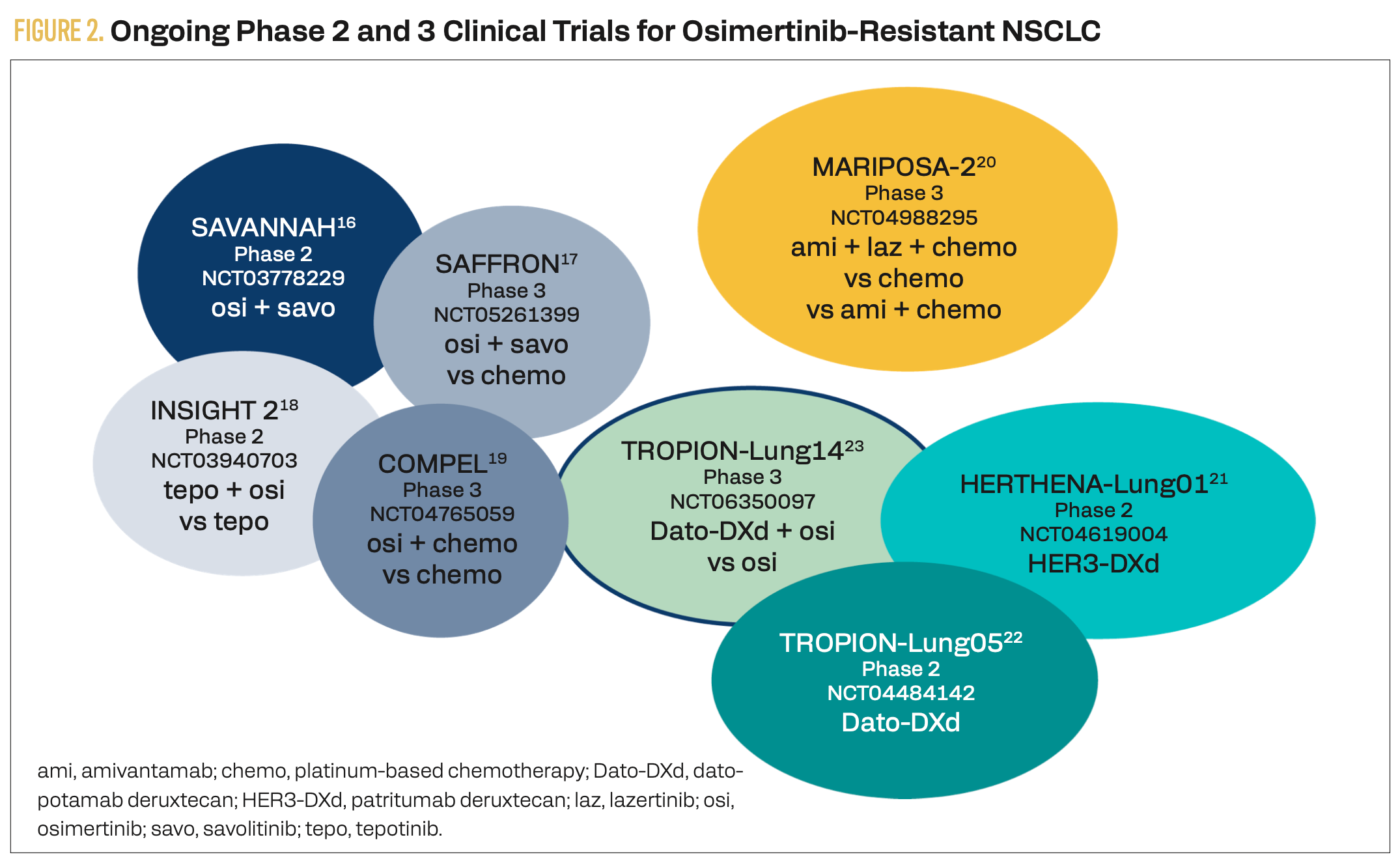3 Things You Should Know About Unresectable NSCLC
In first-line, EGFR-mutated NSCLC, targeted therapies such as osimertinib or amivantamab plus lazertinib are recommended.

RELEASE DATE: April 1, 2025
EXPIRATION DATE: April 1, 2026
LEARNING OBJECTIVES
Upon successful completion of this activity, you should be better prepared to:
- Review evidence-based approaches to managing unresectable non–small cell lung cancer (NSCLC), including the integration of immunotherapy and targeted therapies in unresectable settings.
- Explore patient selection, therapy sequencing, and the management of adverse events to optimize individualized care for patients with EGFR-mutant or immunotherapy-eligible NSCLC.
Accreditation/Credit Designation
Physicians’ Education Resource®, LLC, is accredited by the Accreditation Council for Continuing Medical Education (ACCME) to provide continuing medical education for physicians.
Physicians’ Education Resource®, LLC, designates this enduring material for a maximum of 0.25 AMA PRA Category 1 Credits™. Physicians should claim only the credit commensurate with the extent of their participation in the activity.
Acknowledgment of commercial support
This activity is supported by an educational grant from AstraZeneca Pharmaceuticals.
Off-label disclosure/disclaimer
This activity may or may not discuss investigational, unapproved, or off-label use of drugs. Learners are advised to consult prescribing information for any products discussed. The information provided in this activity is for accredited continuing education purposes only and is not meant to substitute for the independent clinical judgment of a health care professional relative to diagnostic, treatment, or management options for a specific patient’s medical condition. The opinions expressed in the content are solely those of the individual faculty members, and do not reflect those of PER or any company that provided commercial support for this activity.
Instructions for participation/how to receive credit
- Read this activity in its entirety.
- Go to https://www.gotoper.com/ttlc25nsclc-postref to access and complete
the posttest. - Answer the evaluation questions.
- Request credit using the drop-down menu.
YOU MAY IMMEDIATELY DOWNLOAD YOUR CERTIFICATE.
Immunotherapy (IO) and targeted therapy have improved outcomes in patients with EGFR-mutated, advanced, unresectable non–small cell lung cancer (NSCLC). Here are 3 things you should know about advances in the management of unresectable NSCLC.
1. Consolidation IO provides a survival benefit in patients with unresectable stage III NSCLC.
For patients with unresectable stage III NSCLC without EGFR exon 19 deletion or L858R mutation that has spread to local lymph nodes, definitive concurrent chemoradiotherapy (CRT) followed by adjuvant durvalumab is the recommended treatment strategy.1 This recommendation is based on results from the phase 3 PACIFIC trial (NCT02125461), which randomly assigned 713 patients of any PD-L1 expression level to receive either durvalumab or placebo as consolidation therapy.2 Analysis at 5 years demonstrated a benefit with durvalumab in both the median overall survival (OS; HR, 0.72; 95% CI, 0.59-0.89) and the median progression-free survival (PFS; HR, 0.55; 95% CI, 0.45-0.68).
Real-world data from the observational, retrospective PACIFIC-R study (NCT03798535) of durvalumab consolidation post CRT in 1154 participants with unresectable stage III NSCLC indicated a median OS that was not reached (NR; 95% CI, 46.3-not estimable), with a 3-year OS rate of 63.2% (95% CI, 60.3%-65.9%).3 The median PFS was 24.1 months (95% CI, 20.2-27.8), and the 3-year PFS rate was 42.2% (95% CI, 39.2%-45.1%). Patients with PD-L1 expression greater than 1% experienced higher 3-year OS rates than patients with PD-L1 less than 1% (67.0% vs 54.4%).
Radiotherapy can induce expression of CD73, PD-L1, and the NKG2A ligand, resulting in an immunosuppressive tumor microenvironment. Therefore, the phase 2 COAST trial (NCT03822351) evaluated whether combining anti-NKG2A monalizumab (M) or anti-CD73 oleclumab (O) with anti–PD-L1 durvalumab (D) in the adjuvant setting might further improve outcomes for patients with unresectable stage III NSCLC.4 A total of 189 patients were randomly assigned 1:1:1 to receive D with or without M or O. Confirmed objective response rates in each of the 3 arms, respectively, were 23.9% (95% CI, 14.3%-35.9%), 35.0% (95% CI, 23.1%-48.4%), and 40.3% (28.1%-53.6%). Treatment discontinuation due to progressive disease or adverse events (AEs) occurred in 69.7%, 44.1%, and 41.0% of patients receiving D, D+O, and D+M, respectively. AEs of grade 3 or 4 were reported in 34.8%, 33.9%, and 32.8% of patients in the D, D+O, and D+M arms, respectively. Further investigations with durvalumab are outlined in the Table.5-7
TABLE. Phase 3 Clinical Trials of Durvalumab in Patients With Unresectable Stage III NSCLC

2. Targeted therapy is the recommended treatment in first-line EGFR-mutated NSCLC.
Exon 19 deletions and the L858R point mutation comprise the majority of cases of EGFR alterations in NSCLC (Figure 1).8 For patients with advanced or metastatic NSCLC harboring one of these mutations, osimertinib is an established first-line therapy based on results from the FLAURA trial (NCT02296125).9 In this study, 556 participants were randomly assigned 1:1 to receive either osimertinib or another EGFR inhibitor (gefitinib or erlotinib). Osimertinib demonstrated a statistically significant benefit in terms of both PFS (18.9 months vs 10.2 months; HR, 0.46; P < .001) and OS (38.6 months vs 31.8 months; HR, 0.80; P = .046). Similar rates of AEs were reported in both groups.
FIGURE 1. EGFR Mutations in NSCLC8

The follow-up phase 3 FLAURA2 trial (NCT04035486) investigated the benefits of adding chemotherapy to frontline osimertinib.10 A total of 557 treatment-naive patients were randomly assigned 1:1 to receive osimertinib with or without platinum-based chemotherapy. Median PFS was significantly longer with combination therapy vs monotherapy (HR, 0.62; 95% CI, 0.49-0.79; P < .001). The median OS was NR (95% CI, 38.0-not calculable [NC]) in the osimertinib plus chemotherapy group vs 36.7 months (95% CI, 33.2-NC) in the osimertinib monotherapy group (HR, 0.75; 95% CI, 0.57-0.97).11 AEs of grade 3 or greater were reported in 64% of patients receiving osimertinib plus chemotherapy vs 27% of patients receiving osimertinib monotherapy.10
Combination amivantamab plus lazertinib is a therapeutic option for either previously untreated or osimertinib-pretreated patients with EGFR-mutated advanced NSCLC.1 In the phase 3 MARIPOSA trial (NCT04487080), 1074 treatment-naive patients were randomly assigned 2:2:1 to receive amivantamab plus lazertinib, osimertinib, or lazertinib.12 The median PFS was significantly longer in the amivantamab plus lazertinib group as compared with the osimertinib group (HR, 0.70; 95% CI, 0.58-0.85; P < .001). Median OS in the amivantamab plus lazertinib arm was not estimable vs 37.3 months in the osimertinib arm (HR, 0.77; 95% CI, 0.61-0.96; nominal P = .019).13 Discontinuation of therapy occurred in 10% of patients receiving amivantamab plus lazertinib vs 3% of patients receiving osimertinib.12
3. Novel combinations and therapeutics aim to overcome resistance to osimertinib.
NSCLC tumor cells can develop resistance to EGFR inhibitors through a variety of mechanisms, including additional EGFR mutations, amplifications, fusions, or mutations in other pathways.14 The ongoing phase 2 ORCHARD trial (NCT03944772) assembled molecular profiles of patients with advanced EGFR-mutated NSCLC who experienced progression after treatment with osimertinib with the aim of developing individualized treatment plans based on the mechanism of resistance to osimertinib.15 Patients with targetable biomarkers of resistance (group A) will be treated with novel osimertinib combination therapies. Patients without targetable biomarkers (group B) will receive treatment based on chemotherapy or EGFR inhibitors. Patients with histologically transformed disease (group C) will be treated as per local practice. The end points are PFS, duration of response, OS, pharmacokinetics, and safety. Numerous other clinical trials are evaluating additional therapeutic options, including antibody-drug conjugates and novel combinations of osimertinib and other targeted therapies, for patients whose disease has developed resistance to osimertinib (Figure 2).16-23
FIGURE 2. Ongoing Phase 2 and 3 Clinical Trials for Osimertinib-Resistant NSCLC

Key References
4. Aggarwal C, Martinez-Marti A, Majem M, et al. Updated results from COAST, a phase 2 study of durvalumab (D) ± oleclumab (O) or monalizumab (M) in patients (pts) with stage III unresectable non-small cell lung cancer (uNSCLC). J Clin Oncol. 2024;42(suppl 16):8046.
12. Cho BC, Lu S, Felip E, et al; MARIPOSA Investigators. Amivantamab plus lazertinib in previously untreated EGFR-mutated advanced NSCLC. N Engl J Med. 2024;391(16):1486-1498. doi:10.1056/NEJMoa2403614
15. Yu HA, Goldberg SB, Le X, et al. Biomarker-directed phase II platform study in patients with EGFR sensitizing mutation-positive advanced/metastatic non-small cell lung cancer whose disease has progressed on first-line osimertinib therapy (ORCHARD). Clin Lung Cancer. 2021;22(6):601-606. doi:10.1016/j.cllc.2021.06.006
For full reference list, visit https://www.gotoper.com/ttlc25nsclc-postref
To learn more about this topic, including information on additional immunotherapy combinations and novel targeted therapies under investigation for the treatment of patients with unresectable or metastatic NSCLC, go to https://www.gotoper.com/ttlc25nsclc-activity
CME Posttest Questions
1. A 70-year-old woman with unresectable stage III lung adenocarcinoma, PD-L1 expression of 40%, and next-generation sequencing showing a KRAS G12C alteration (T3N2M0) has completed concurrent chemoradiotherapy. What is the most appropriate next step in management?
A. Observation
B. Adjuvant chemotherapy
C. Consolidation durvalumab
D. Maintenance KRAS G12C inhibitor
2. A 66-year-old woman, never-smoker, presents with a persistent cough and fatigue. Imaging reveals a 6-cm mass in the right upper lobe, mediastinal lymphadenopathy, and adrenal nodule. PET-CT shows bone lesions, and brain MRI demonstrates brain lesions. Performance status was 0. A biopsy confirms adenocarcinoma, and molecular testing identifies an EGFR exon 21 L858R mutation. Which of the following would you choose as the first-line treatment approach for this patient?
A. Osimertinib monotherapy
B. Osimertinib plus chemotherapy
C. Amivantamab plus lazertinib
D. Chemoradiation followed by durvalumab consolidation
Claim Your CME Credit at https://www.gotoper.com/ttlc25nsclc-postref
CME Provider Contact information
Physicians’ Education Resource®, LLC
2 Commerce Drive, Suite 110, Cranbury, NJ 08512
Toll-Free: 888-949-0045
Local: 609-378-3701
Fax: 609-257-0705
info@gotoper.com

Newsletter
Stay up to date on recent advances in the multidisciplinary approach to cancer.